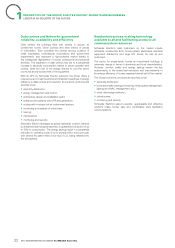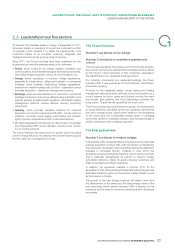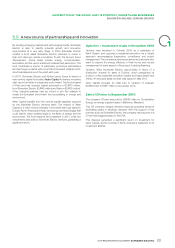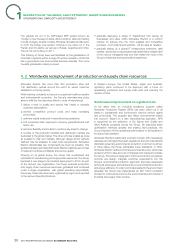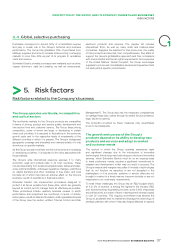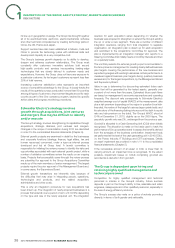APC 2010 Annual Report Download - page 34
Download and view the complete annual report
Please find page 34 of the 2010 APC annual report below. You can navigate through the pages in the report by either clicking on the pages listed below, or by using the keyword search tool below to find specific information within the annual report.
DESCRIPTION OFTHEGROUP, ANDITSSTRATEGY, MARKETS ANDBUSINESSES
1INNOVATION AND R&D: SERVINGGROWTH
Schneider Electric complements the results of this project with its
own research into combining within the same product certifi ed
embedded software, which ensures safe operation, and open
software enabling related, evolving functions to be developed more
rapidly.
The other partners involved in the project are: CEA Grenoble –
Orange Labs – INRIA Rhône Alpes – IS2T – Itris Automation Square
– Logica IT Services – Sogeti High Tech – STMicroelectronics – ST
Ericsson – Université Joseph Fourier - INERIS – Verimag – LaSTRE
– LASQUO/ISTIA..
Sustainable development projects
Schneider Electric has also teamed up with the French agency
for environment and energy management (ADEME), EDF, Renault
and Total to support a prospective modeling for sustainable
development chair at ParisTech. To meet the challenges of
sustainable development, both businesses and public offi cials need
to think long-term when making strategic choices. The Chair’s
mission is to provide common tools for decision makers, experts
and scientists while focusing on the articulation between short-,
medium-, and long-term needs and the interface between business,
resource management and climate. In 2010, the Chair strengthened
the contribution of Schneider Electric at the World Energy Congress
held in Montreal in September by presenting prospective thinking
on the regional implications of the global emissions commitments
made at the UN Climate Change Conference (COP15), and
subsequently participated in a round table discussion on smart
grids at the Cancun conference (COP16). Going forward, the
work undertaken by the Chair should make it clearer which energy
effi ciency technologies and applications are the best investment in
which region over the short and long term.
In the context of its social commitments, Schneider Electric is
leading a project with the objective of designing and building a new
type of solar power plant in which 10kW units will use the sun’s rays
to activate a thermodynamic machine that can drive an alternator.
Unlike existing photovoltaic plants, which use batteries, these units
will use an eco-designed heat storage unit made from local green
materials. This project fi ts in with the Group’s efforts to deliver
electricity from renewables to people in emerging economies. The
ten SMEs and research laboratories partnering the project are
participating through the BipBop program to provide their technical
skills and gain access to new markets.
A deep commitment within the R&D
community
Schneider Electric plays an active role in the French and international
R&D community, notably in defi ning strategic R&D programs and in
evaluating projects currently under way or submitted to France’s
business clusters, France’s national research agency or European
organisations such as FP7, ITEA (Information Technology for
European Advancement), KIC (Knowledge Innovation Community,
InnoEnergy and PPP E2B (Public-Private Partnership on Energy-
Effi cient Buildings). The two main business clusters include
Minalogic, specialised in microtechnologies, nanotechnologies
and embedded software and Tenerrdis, which focuses on new
energy technologies and renewable energies.
Schneider Electric is involved in the main skills network, the Organic
Electronic Association, and is a promoter of “green electronics” in
relation to its WG-Green working group. It heads up the “Intelligent
Product” unit for the Plastipolis business cluster, and participates
in discussions with the French scientifi c community in the context
of the Organic electronics research group. Large area electronics
also provide an opportunity for innovation for Group products:
this technology is likely to bring greater fl exibility in design, as well
as space gains and new functions on the surface of electronic
products: printed buttons, autonomous screens, etc.
Schneider Electric is also a member of the EMMI (European
Multifunctional Materials Institute) support group, whose main
objective is to serve as a common platform for its 15 academic
members in seven European countries to defi ne and execute
research or educational projects in the area of multifunctional
materials. EMMI enables different communities to share views
about functional ceramics and organic-inorganic hybrid materials,
etc. Environmental issues play a key role in much of the members’
resulting work. Examples include projects to design new materials
or systems to reduce electrical consumption, projects to replace
toxic components and a project to develop hypersensitive gas
sensors. In this context, Schneider Electric is supporting a thesis
begun in 2009, and is backing two thesis subjects for 2011.
2010 REGISTRATION DOCUMENT SCHNEIDER ELECTRIC32


